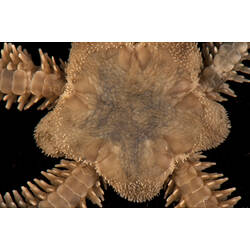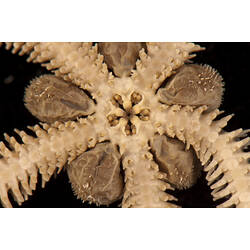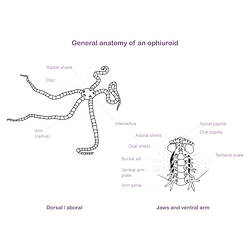General Description
Medium-sized species, disc covered in scales with some small spines along the margin and ventrally. Arms up to six times disc diameter with 3-4 short arm spines on the side of each segment. One oval tentacle scale. Single tricuspid tooth at the apex of each jaw and two small oval papillae on each side. Disc olive green or dark grey, radial shields a contrasting white, arms often with blotches on green pigment spaced on either side of the dorsal midline. Older animals with faded pigmentation.
Biology
This species reproduces by releasing eggs or sperm in May-June. The resulting larvae are called ophiopleuti, have long calcite spines, can feed on phytoplankton and swim for three months before settlement. Ophiactis resiliens is a suspension feeder; individuals bury their discs in coarse sediments, under rocks, or in rock crevices, with 1-4 arms extending vertically into the current. The arms alter their orientation according to the current flow, and the tube feet are widely spread laterally. Particles of food are caught on the papillate tube feet, less commonly on the arm spines, and are transferred to the mouth in a "collapsing wave" of tube feet. Near the arm base the food is compressed into a bolus that is passed to the mouth. Ingested food consists mainly of diatoms.
Distribution
New Zealand and Tasman Sea, including southern and eastern Australia.
Habitat
Reefs, brown algae, sponge and bryozoan beds, under rocks and on holdfasts of kelp.
More Information
-
Animal Type
-
Animal SubType
-
Brief Id
Disc covered in scales with small spines at edge, 3-4 spines per arm segment, one tentacle scale.
-
Habitats
-
Diet
Plankton or Particles
-
Endemicity
-
Commercial
No
-
Conservation Statuses
DSE Advisory List: Not listed, EPBC Act 1999: Not listed, IUCN Red List: Not listed
-
Depths
Shallow (1-30 m)
-
Water Column Locations
On or near seafloor
-
Taxon Name
-
Scientific Author
Lyman, 1879
-
Common Name
Brittle Star
-
Phylum
-
Subphylum
-
Class
-
Subclass
-
Superorder
-
Order
-
Suborder
-
Superfamily
-
Family
-
Genus
-
Species Name
resiliens





